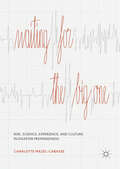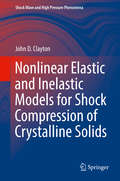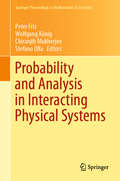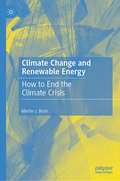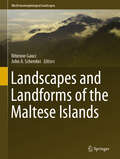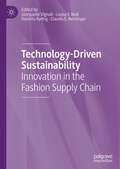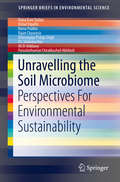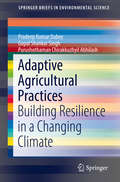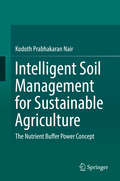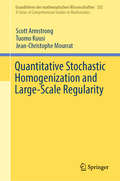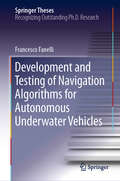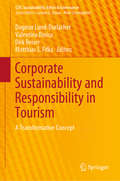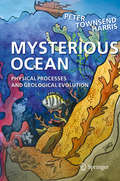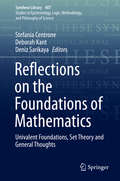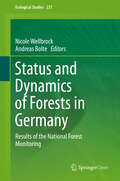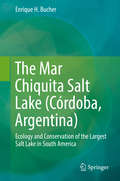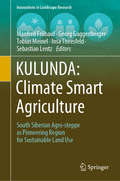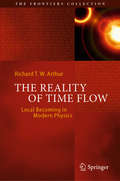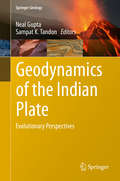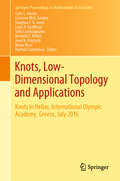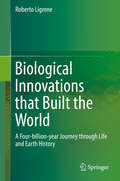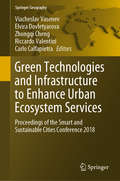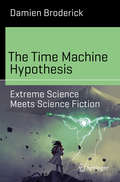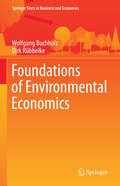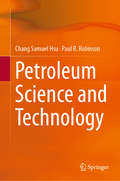- Table View
- List View
Waiting for the Big One: Risk, Science, Experience, and Culture in Disaster Preparedness
by Charlotte Mazel-CabasseThis book helps understand how the future Big One (a large-scale and often-predicted earthquake) is understood, defined, and mitigated by experts, scientists, and residents in the San Francisco Bay Area. Following the idea that earthquake risk is multiple and hard to grasp, the book explores the earthquake’s “mode of existence,” guiding the reader through different epistemic moments of the earthquake-risk definition. Through in-depth interviews, the book provides a rarely seen anthropology of risk from the perspective of experts, scientists, and concerned residents for whom the possibility of partial or complete destruction of their living environment is a constant companion of their everyday lives. It argues that the characterization of the threats and the measures taken to limit its impacts constitute an integrated part of both their residential experiences and their professional practices.
Nonlinear Elastic and Inelastic Models for Shock Compression of Crystalline Solids (Shock Wave and High Pressure Phenomena)
by John D. ClaytonThis book describes thermoelastic and inelastic deformation processes in crystalline solids undergoing loading by shock compression. Constitutive models with a basis in geometrically nonlinear continuum mechanics supply these descriptions. Large deformations such as finite strains and rotations, are addressed. The book covers dominant mechanisms of nonlinear thermoelasticity, dislocation plasticity, deformation twinning, fracture, flow, and other structure changes. Rigorous derivations of theoretical results are provided, with approximately 1300 numbered equations and an extensive bibliography of over 500 historical and modern references spanning from the 1920s to the present day. Case studies contain property data, as well as analytical, and numerical solutions to shock compression problems for different materials. Such materials are metals, ceramics, and minerals, single crystalline and polycrystalline.The intended audience of this book is practicing scientists (physicists, engineers, materials scientists, and applied mathematicians) involved in advanced research on shock compression of solid materials.
Probability and Analysis in Interacting Physical Systems: In Honor of S.R.S. Varadhan, Berlin, August, 2016 (Springer Proceedings in Mathematics & Statistics #283)
by Peter Friz Wolfgang König Chiranjib Mukherjee Stefano OllaThis Festschrift on the occasion of the 75th birthday of S.R.S. Varadhan, one of the most influential researchers in probability of the last fifty years, grew out of a workshop held at the Technical University of Berlin, 15–19 August, 2016. This volume contains ten research articles authored by several of Varadhan's former PhD students or close collaborators. The topics of the contributions are more or less closely linked with some of Varadhan's deepest interests over the decades: large deviations, Markov processes, interacting particle systems, motions in random media and homogenization, reaction-diffusion equations, and directed last-passage percolation. The articles present original research on some of the most discussed current questions at the boundary between analysis and probability, with an impact on understanding phenomena in physics. This collection will be of great value to researchers with an interest in models of probability-based statistical mechanics.
Climate Change and Renewable Energy: How to End the Climate Crisis
by Martin J. BushThis book presents a comprehensive overview of the global climate change impacts caused by the continued use of fossil fuels, which results in enormous damage to the global environment, biodiversity, and human health. It argues that the key to a transition to a low carbon future is the rapid and large-scale deployment of renewable energy technologies in power generation, transport and industry, coupled with super energy-efficient building design and construction. However, the author also reveals how major oil companies and petrochemical conglomerates have systematically attempted to manufacture doubt and uncertainty about global warming and climate change, continue to block the commercialization of solar energy and wind power, and impede the electrification of the transport sector. Martin Bush’s solution is a theory-of-change approach to substantially reduce greenhouse-gas emissions by 2050, which sets out realistic steps that people can take now to help make a difference.
Landscapes and Landforms of the Maltese Islands (World Geomorphological Landscapes)
by Ritienne Gauci John A. SchembriThis edited volume brings together a collection of works that comprehensively address both the myriad geomorphological landscapes of the Maltese Islands and how their evolution has been shaped over various time-scales by different sets of processes. Additionally, the work highlights how the small geographical setting of the Maltese Islands helped to closely connect these landscapes with Maltese society and as a result, they have evolved from stand-alone examples of geomorphology to important backdrops of Maltese cultural identity. Most of the contributing authors are academics – both local and foreign – with a research focus on the geomorphology of the Maltese Islands. However, the editors have also (and purposefully) chosen other contributors from governmental institutions and research agencies, who complement the geomorphological research with their proactive work in selected case studies on Maltese landscapes.
Technology-Driven Sustainability: Innovation in the Fashion Supply Chain
by Claudia E. Henninger Daniella Ryding Gianpaolo Vignali Louise F. ReidThis book provides a critical overview of technologies that are used within the fashion industry and supply chain, with a special emphasis on how they engender sustainability and the circular economy. The chapters present contemporary case studies alongside new research on technologies such as 3D printing, 3D scanning and recycling technology to assess the effect they will have on the future of fashion and its global supply chain.
Unravelling the Soil Microbiome: Perspectives For Environmental Sustainability (SpringerBriefs in Environmental Science)
by Rama Kant Dubey Vishal Tripathi Ratna Prabha Rajan Chaurasia Dhananjaya Pratap Singh Ch. Srinivasa Rao Ali El-Keblawy Purushothaman Chirakkuzhyil AbhilashThis book explores the significance of soil microbial diversity to understand its utility in soil functions, ecosystem services, environmental sustainability, and achieving the sustainable development goals. With a focus on agriculture and environment, the book highlights the importance of the microbial world by providing state-of-the-art technologies for examining the structural and functional attributes of soil microbial diversity for applications in healthcare, industrial biotechnology, and bioremediation studies. In seven chapters, the book will act as a primer for students, environmental biotechnologists, microbial ecologists, plant scientists, and agricultural microbiologists. Chapter 1 introduces readers to the soil microbiome, and chapter 2 discusses the below ground microbial world. Chapter 3 addresses various methods for exploring microbial diversity, chapter 4 discusses the genomics methods, chapter 5 provides the metaproteomics and metatranscriptomics approaches and chapter 6 details the bioinformatics tools for soil microbial community analysis, and chapter 7 concludes the text with future perspectives on further soil microbial uses and applications.
Adaptive Agricultural Practices: Building Resilience in a Changing Climate (SpringerBriefs in Environmental Science)
by Pradeep Kumar Dubey Gopal Shankar Singh Purushothaman Chirakkuzhyil AbhilashThis brief explores several adaptive agricultural practices from around the world to fulfill current and future agricultural demands for food security due to the challenges posed by climate change and growing global population. Readers will discover how farmers adapt to environmental changes by adopting various agronomic practices at crop, farm and landscape levels. Particular attention is given to systemic and transformational adaptation strategies employed by farmers such as mulching, organic farming and crop diversification. This is a highly informative and carefully presented book that provides insights on how crops can build up resilience against periods of drought, high salinity, disasters such as floods, and diseases. The policy implications and future prospects of these adaptation strategies are also addressed. Environmental and plant scientists, agronomists and researchers in climate sciences will find this book interesting.
Intelligent Soil Management for Sustainable Agriculture: The Nutrient Buffer Power Concept
by Kodoth Prabhakaran NairThis book conceptualizes a revolutionary idea based on a mechanistic-mathematical model in which the “Buffer Power” of the principal and problematic nutrients like phosphorus, potassium and zinc is quantified. This is achieved by using either a very sophisticated technique, electro-ultra-filtration, or a simple adsorption-desorption equilibrium technique, and by integrating the “Buffer Power” of the nutrient in question into the computations, accurate fertilizer recommendations are made. This technique was field tested across Europe, (Germany and Belgium), Africa (The Republic of Cameroon), and Asia (both Central Asia- Turkey and South Asia-India), during a period of three decades in test crops, such as, summer rye (Secale cereale), maize (Zea mays), wheat (Triticum aestivum), white clover (Trifolium repens), a highly nutritious and palatable fodder crop for Africa, black pepper (Piper nigrum) and cardamom (Elettaria cardamomum). Remarkable precision in predictability of plant uptake of phosphorus, potassium and zinc was obtained employing the technique.“The Nutrient Buffer Power Concept” project was shortlisted for the very prestigious U.S. $1 Million Rolex Awards For Enterprise of The Rolex Foundation, Geneva, Switzerland, for its outstanding originality and quality from more than 3500 nominations worldwide and is the only project chosen for this very coveted distinction from the Asian continent.
Quantitative Stochastic Homogenization and Large-Scale Regularity (Grundlehren der mathematischen Wissenschaften #352)
by Scott Armstrong Tuomo Kuusi Jean-Christophe MourratThe focus of this book is the large-scale statistical behavior of solutions of divergence-form elliptic equations with random coefficients, which is closely related to the long-time asymptotics of reversible diffusions in random media and other basic models of statistical physics. Of particular interest is the quantification of the rate at which solutions converge to those of the limiting, homogenized equation in the regime of large scale separation, and the description of their fluctuations around this limit. This self-contained presentation gives a complete account of the essential ideas and fundamental results of this new theory of quantitative stochastic homogenization, including the latest research on the topic, and is supplemented with many new results. The book serves as an introduction to the subject for advanced graduate students and researchers working in partial differential equations, statistical physics, probability and related fields, as well as a comprehensive reference for experts in homogenization. Being the first text concerned primarily with stochastic (as opposed to periodic) homogenization and which focuses on quantitative results, its perspective and approach are entirely different from other books in the literature.
Development and Testing of Navigation Algorithms for Autonomous Underwater Vehicles (Springer Theses)
by Francesco FanelliThis book focuses on pose estimation algorithms for Autonomous Underwater Vehicles (AUVs). After introducing readers to the state of the art, it describes a joint endeavor involving attitude and position estimation, and details the development of a nonlinear attitude observer that employs inertial and magnetic field data and is suitable for underwater use. In turn, it shows how the estimated attitude constitutes an essential type of input for UKF-based position estimators that combine position, depth, and velocity measurements. The book discusses the possibility of including real-time estimates of sea currents in the developed estimators, and highlights simulations that combine real-world navigation data and experimental test campaigns to evaluate the performance of the resulting solutions. In addition to proposing novel algorithms for estimating the attitudes and positions of AUVs using low-cost sensors and taking into account magnetic disturbances and ocean currents, the book provides readers with extensive information and a source of inspiration for the further development and testing of navigation algorithms for AUVs.
Corporate Sustainability and Responsibility in Tourism: A Transformative Concept (CSR, Sustainability, Ethics & Governance)
by Matthias S. Fifka Dagmar Lund-Durlacher Dirk Reiser Valentina DinicaThis book offers essential insights into how the world's second largest industry, tourism, is responding to challenges involved in expanding the corporate social responsibility (CSR) concept to corporate sustainability and responsibility, referred to as CSR 2.0. It analyzes the typical setup of tourism with various types of commercial agents: corporations, small and medium sized enterprises, public-private partnerships, social enterprises and local cooperatives. In addition, the book examines a broad range of voluntary initiatives, the effectiveness of these efforts, and how contextual and wider policy features shape these relationships. The book is divided into three parts, the first of which elaborates on strategic drivers and rationales for CSR. In turn, the second part introduces readers to design approaches for CSR programs and envisaged impacts, while part three focuses on implementation, certification, reporting, and possible outcomes. Each part offers a mixture of theoretical perspectives, synthesis analyses and case studies. The respective chapters tackle a broad spectrum of tourism sub-sectors, e.g. the cruise industry, aviation, gastronomy, nature-based tourism, and urban destinations.
Mysterious Ocean: Physical Processes and Geological Evolution (Springer Oceanography Ser.)
by Peter Townsend HarrisThis book provides an introduction to ocean sciences that is engaging, evocative and accessible to non-experts interested in marine geoscience, while sparking readers' interest in important unsolved mysteries in marine science. The scope of the book is quite broad, but focuses on the physical ocean and its geological evolution, including the author's experiences working as an oceanographer over the last thirty years. Across ten chapters, the book traces the origins of the ocean from its formation 4 billion years ago, reviews the discoveries of the theory of plate tectonics, the ice ages and the great ocean conveyor, and discusses seafloor features (canyons, seamounts, trenches, abyssal plains, etc.), how they formed and their current environmental issues. The book concludes with a prognosis for the future ocean we might expect with global climate change and other human impacts.
Reflections on the Foundations of Mathematics: Univalent Foundations, Set Theory and General Thoughts (Synthese Library #407)
by Stefania Centrone Deborah Kant Deniz SarikayaThis edited work presents contemporary mathematical practice in the foundational mathematical theories, in particular set theory and the univalent foundations. It shares the work of significant scholars across the disciplines of mathematics, philosophy and computer science. Readers will discover systematic thought on criteria for a suitable foundation in mathematics and philosophical reflections around the mathematical perspectives.The volume is divided into three sections, the first two of which focus on the two most prominent candidate theories for a foundation of mathematics. Readers may trace current research in set theory, which has widely been assumed to serve as a framework for foundational issues, as well as new material elaborating on the univalent foundations, considering an approach based on homotopy type theory (HoTT). The third section then builds on this and is centred on philosophical questions connected to the foundations of mathematics. Here, the authors contribute to discussions on foundational criteria with more general thoughts on the foundations of mathematics which are not connected to particular theories.This book shares the work of some of the most important scholars in the fields of set theory (S. Friedman), non-classical logic (G. Priest) and the philosophy of mathematics (P. Maddy). The reader will become aware of the advantages of each theory and objections to it as a foundation, following the latest and best work across the disciplines and it is therefore a valuable read for anyone working on the foundations of mathematics or in the philosophy of mathematics.
Status and Dynamics of Forests in Germany: Results of the National Forest Monitoring (Ecological Studies #237)
by Nicole Wellbrock Andreas BolteThis book is an open access publication.Forest ecosystems in Central Europe are changing as a result of anthropogenic influences and changing climate conditions. As such, a large-scale monitoring programme was undertaken in order to understand the influence of site modification, deposition of air pollutants, and climate. This book presents the scientific findings of this study for Germany, including the major challenges with regard to the future preservation and management of forest ecosystems under environmental change. In addition, it addresses a number of central questions: what are the main factors affecting forest stands and soil integrity? How, and how rapidly, are forest ecosystems changing? How diverse are the changes across Germany? What will be the main risks in sustainable forest management in the future? And how can policy support the development and maintenance of adaptive and resilient forests that provide essential ecosystem services, today and in the future? Helping readers understand the importance of soils and related ecosystem processes for future sustainable forestry, and sharing essential findings on environmental change and related changes in forest status and dynamics, the book is a valuable resource for researchers and policymakers interested in science-based decisions.
The Mar Chiquita Salt Lake (Córdoba, Argentina): Ecology and Conservation of the Largest Salt Lake in South America
by Enrique H. BucherThis book provides a comprehensive, updated syntheses of all the information available on Mar Chiquita, covering various aspects of the geography, geological history, biology and ecology of the site, as well as a detailed analysis of the current land-use patterns, environmental threats, and conservation issues. Mar Chiquita, located in the province of Cordoba, Argentina, is a protected wilderness area that includes South America’s largest saline lake and wetland. It has a very rich bird biodiversity, including three of the six species of flamingos that exist in the world, and high numbers of intercontinental migratory shorebirds. For this reason, the area has been declared an International Site by the Ramsar Convention on Wetlands of International Importance, and also a Site of Hemispheric Importance by the Western Hemisphere Shorebird Reserves Network. Largely unknown until very recently, particularly in terms of the English literature, the site is rapidly gaining international visibility, not only in terms of scientific research, but also as site of interest for the nature lovers around the globe. Written in a language accessible to the non-specialists, the book focuses on integrating the dynamic, functional processes in the ecosystem, while at the same time providing the necessary descriptive information. Accordingly, it is of interest to scientists from diverse disciplines interested in saline wetlands, as well as to students, managers, and the general public.
KULUNDA: South Siberian Agro-steppe as Pioneering Region for Sustainable Land Use (Innovations in Landscape Research)
by Manfred Frühauf Georg Guggenberger Tobias Meinel Insa Theesfeld Sebastian LentzThis book focuses on a representative example and one of the world’s largest steppe conversions, and provides a detailed overview of the results of the BMBF-funded research project KULUNDA. As part of the Siberian virgin land policy, the Kulunda steppe was transformed into agricultural land from 1954 to 1965. In the course of the project, a multidisciplinary research team conducted a natural, social-economic and agro-scientific cause-and-effect analysis of (agro-)ecosystem destabilisation, as well as various field trials covering tillage and crop rotation options in their socio-economic context. The ecologically and economically sound findings offer strategies for combining climate smart land utilization, ecosystem restoration and sustainable regional development, and can readily be applied to other virgin land conversion efforts. In addition, the findings on the Eurasian steppes will expand the current conversion literature, which mainly consists of the ‘Dust Bowl’ literature of the North American plains. Given its scope, the book will appeal to scientists, professionals, and students in the environmental, geo- and climate sciences.
The Reality of Time Flow: Local Becoming in Modern Physics (The Frontiers Collection)
by Richard T. ArthurIt is commonly held that there is no place for the 'now’ in physics, and also that the passing of time is something subjective, having to do with the way reality is experienced but not with the way reality is. Indeed, the majority of modern theoretical physicists and philosophers of physics contend that the passing of time is incompatible with modern physical theory, and excluded in a fundamental description of physical reality. This book provides a forceful rebuttal of such claims. In successive chapters the author explains the historical precedents of the modern opposition to time flow, giving careful expositions of matters relevant to becoming in classical physics, the special and general theories of relativity, and quantum theory, without presupposing prior expertise in these subjects. Analysing the arguments of thinkers ranging from Aristotle, Russell, and Bergson to the proponents of quantum gravity, he contends that the passage of time, understood as a local becoming of events out of those in their past at varying rates, is not only compatible with the theories of modern physics, but implicit in them.
Geodynamics of the Indian Plate: Evolutionary Perspectives (Springer Geology)
by Neal Gupta Sampat K. TandonThis book provides insights on new geological, tectonic, and climatic developments in India through a time progression from the Archean to the Anthropocene that are captured via authoritative entries from experts in earth sciences. This volume aims to bring graduate students and researchers up to date on the geodynamic evolution of the Indian Plate; concepts that have so far resulted in a rather uneven treatment of the subject at different institutions.The book is divided into 4 sections and includes perspectives such as the formation and evolution of the Indian crust in comparison to its neighbors such as Antarctica, Africa and Australia; the evolution of Precambrian cratons and sedimentary basins of India; and a summary account of early life reported in the Indian stratigraphic record. Readers will also discover the key recent research into the neotectonics, tectonic geomorphology, and paleoseismology of the Himalayan Front. Researchers and students in geology, earth sciences, sedimentology, paleobiology and geography will find this book appealing.
Knots, Low-Dimensional Topology and Applications: Knots in Hellas, International Olympic Academy, Greece, July 2016 (Springer Proceedings in Mathematics & Statistics #284)
by Colin C. Adams Cameron McA. Gordon Vaughan F. R. Jones Louis H. Kauffman Sofia Lambropoulou Kenneth C. Millett Jozef H. Przytycki Renzo Ricca Radmila SazdanovicThis proceedings volume presents a diverse collection of high-quality, state-of-the-art research and survey articles written by top experts in low-dimensional topology and its applications. The focal topics include the wide range of historical and contemporary invariants of knots and links and related topics such as three- and four-dimensional manifolds, braids, virtual knot theory, quantum invariants, braids, skein modules and knot algebras, link homology, quandles and their homology; hyperbolic knots and geometric structures of three-dimensional manifolds; the mechanism of topological surgery in physical processes, knots in Nature in the sense of physical knots with applications to polymers, DNA enzyme mechanisms, and protein structure and function. The contents is based on contributions presented at the International Conference on Knots, Low-Dimensional Topology and Applications – Knots in Hellas 2016, which was held at the International Olympic Academy in Greece in July 2016. The goal of the international conference was to promote the exchange of methods and ideas across disciplines and generations, from graduate students to senior researchers, and to explore fundamental research problems in the broad fields of knot theory and low-dimensional topology. This book will benefit all researchers who wish to take their research in new directions, to learn about new tools and methods, and to discover relevant and recent literature for future study.
Biological Innovations that Built the World: A Four-billion-year Journey through Life and Earth History
by Roberto LigroneThe book is a detailed account of major biological events that contributed to create the present world and our species, with emphasis on cause-effect interrelationships and environmental impact. Its main goal is to guide the reader toward an understanding of the continuity of life across diversity, and of its large-scale interactions with the planet. Combining scientific soundness with a constant effort for clarity, the book begins with a cloud of dust in a corner of the Galaxy and, covering an immense lapse of time, terminates with an organism that ponders about the texture of the Universe. Comprehensive, updated references added to each chapter will help the reader wishing to expand any of the topics. A glossary explains less common technical terms.
Green Technologies and Infrastructure to Enhance Urban Ecosystem Services: Proceedings of the Smart and Sustainable Cities Conference 2018 (Springer Geography)
by Viacheslav Vasenev Elvira Dovletyarova Zhongqi Cheng Riccardo Valentini Carlo CalfapietraThese proceedings of the Smart and Sustainable Cities Conference (SSC) in Moscow from May 23 to 26, 2018 addresses important questions regarding the global trend of urbanization. What are the environmental consequences of megacities’ expansion? What smart solutions can make life in cities safe, comfortable and environmentally friendly? It is projected that 70% of the global population will live in cities by 2050, and as such the book describes how this rapid urbanization will alter the face of the world. Focusing on solutions for the environmental problems of modern megapolises, it discusses advanced approaches and smart technologies to monitor, model and assess the environmental consequences and risks. The contributors present examples of successful sustainable urban development, including management and design of green infrastructure, waste management, run-off purification and remediation of urban soils. The SSC conference and its proceedings offer a valuable contribution to sustainable urban development, and are of interest to the scientific and research community, municipal services, environmental protection agencies, landscape architects, civil engineers, policy makers and other stakeholders in urban management and greenery.
The Time Machine Hypothesis: Extreme Science Meets Science Fiction (Science and Fiction)
by Damien BroderickEvery age has characteristic inventions that change the world. In the 19th century it was the steam engine and the train. For the 20th, electric and gasoline power, aircraft, nuclear weapons, even ventures into space. Today, the planet is awash with electronic business, chatter and virtual-reality entertainment so brilliant that the division between real and simulated is hard to discern. But one new idea from the 19th century has failed, so far, to enter reality—time travel, using machines to turn the time dimension into a two-way highway. Will it come true, as foreseen in science fiction? Might we expect visits to and from the future, sooner than from space? That is the Time Machine Hypothesis, examined here by futurist Damien Broderick, an award-winning writer and theorist of the genre of the future. Broderick homes in on the topic through the lens of science as well as fiction, exploring some fifty different time-travel scenarios and conundrums found in the science fiction literature and film.
Foundations of Environmental Economics (Springer Texts in Business and Economics)
by Wolfgang Buchholz Dirk RübbelkeThis textbook provides a solid introduction to the theoretical and empirical aspects of environmental economics, and their links to environmental policy. It advocates drawing on the economist’s toolbox as a powerful means of finding solutions to environmental problems by addressing the conflict between the societal costs of pollution on the one hand, and the financial costs of emissions reduction on the other. The book presents the main economic theory approaches to handling environmental problems and assessing the monetary value of environmental quality; the most relevant environmental policy instruments and challenges involved in their effective real-world application; and both national and global environmental problems addressed by environmental negotiations and agreements. Given its scope, the book offers a valuable basis of information for students, and for policymakers pursuing effective environmental policies.
Petroleum Science and Technology
by Chang Samuel Hsu Paul R. RobinsonAimed at students and professionals, this book covers every major aspect of petroleum: the origin of fossil hydrocarbons and their chemical/physical properties; discovering hydrocarbon reserves; recovering oil, gas, and bitumen; purifying gas; the chemical and physical characterization of crude oil; refining crudes into fuels and lubricants; and converting simple chemicals into solvents, polymers, fibers, rubbers, coatings, and myriad other products, including pharmaceuticals. Readers will learn how the industry operates, from "upstream" exploration and production, "midstream" transportation to "downstream" refining, and manufacturing of finished products. The book also contains unique chapters on midstream operations, learnings from major accidents, and safety/environmental laws and regulations. It builds on the authors' previous books and teaching material from a highly rated course that is taught at the Florida A&M University/Florida State University (USA).
